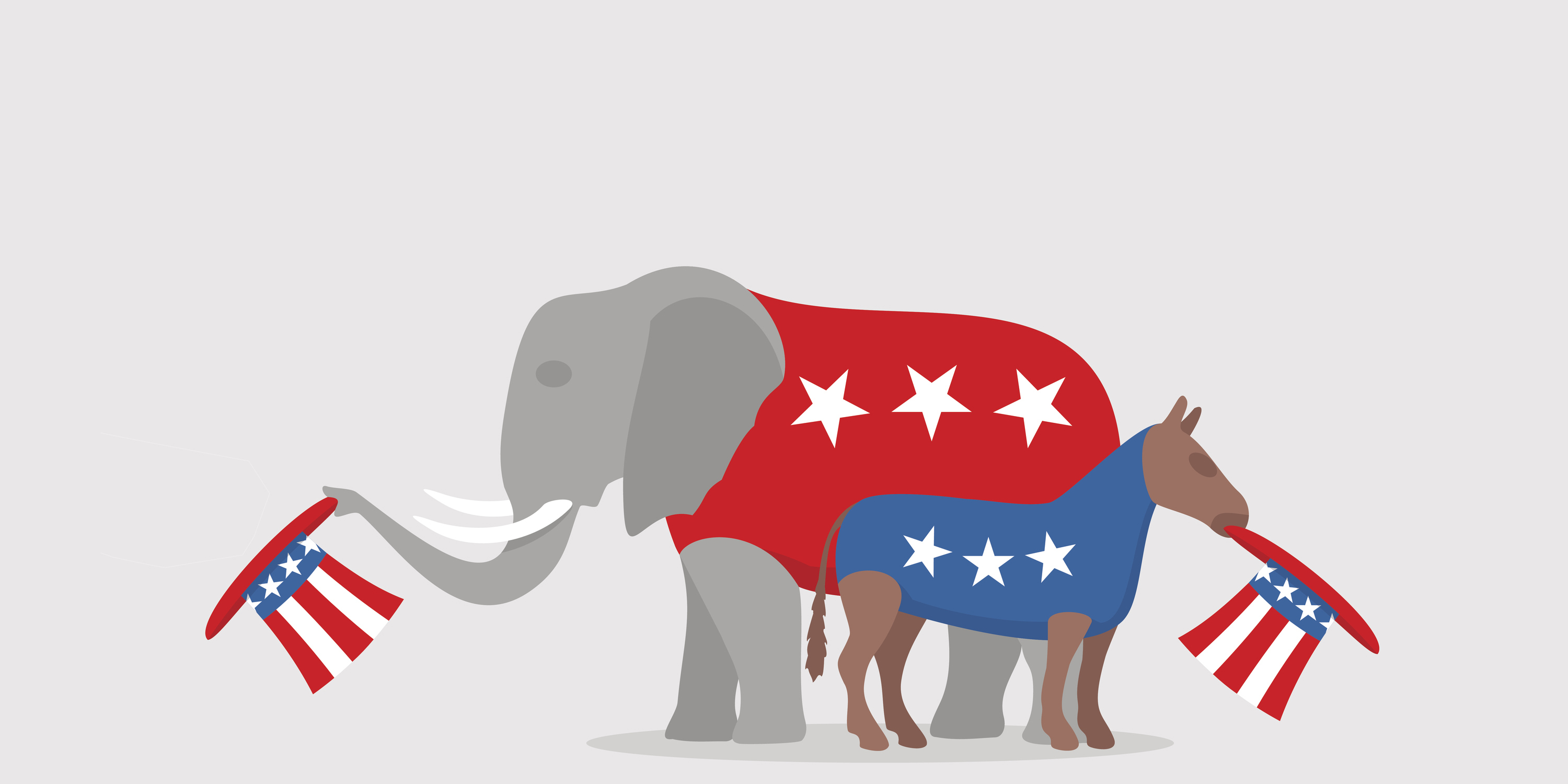The stunning end of the left and right
A metaphor meant to enhance our clarity of thinking, the directional image is fast becoming a hindrance to it. That may mean the metaphor needs to be scrapped and replaced by another.


"Left" and "right" are quickly losing all political meaning.
The Republican president-elect is now linked arm-in-arm with conservatives Sean Hannity and Sarah Palin in praise of cyber-anarchist Julian Assange's attacks on our own country's intelligence services. This has got to be the surest sign yet that we have entered a new ideological era in which the old categories and assumptions simply do not apply.
I don't just mean the end of the post-Cold War era or even the neoliberal one that first swept to power with the elections of Margaret Thatcher and Ronald Reagan nearly four decades ago. I mean, at least potentially, the collapse of the left-right spectrum as we've known it from the time of its emergence from the upheavals of the French Revolution.
The Week
Escape your echo chamber. Get the facts behind the news, plus analysis from multiple perspectives.

Sign up for The Week's Free Newsletters
From our morning news briefing to a weekly Good News Newsletter, get the best of The Week delivered directly to your inbox.
From our morning news briefing to a weekly Good News Newsletter, get the best of The Week delivered directly to your inbox.
In the National Assembly in Paris, the radical revolutionaries sat on the left, the defenders of the power of the monarchy and Roman Catholic Church sat on the right, and the advocates of incremental (liberal) reforms sat in the center. Precisely what policies and ideological visions have been embraced by left, right, and center in various national contexts has changed considerably over time and from place to place. But except for certain exceptional moments, the relation of each point on the spectrum to the others at any given moment has remained stable and recognizable.
A Marxist favoring a total revolution to bring about a radically universalistic-egalitarian socioeconomic order belongs on the far left. A fascist seeking to bring a particular society into conformity with a militaristic model of total mobilization belongs on the far right. And someone favoring the institutions of liberal democracy — individual rights to life, liberty, property, worship, speech, and expression; free and fair elections; an independent judiciary; civilian control of the military — resides somewhere in the center.
Unlike the nations of Europe and Latin America, many of which have histories of genuinely radical (far-left) and reactionary (far-right) political movements, American politics has tended to play out in the broad center of the spectrum, with presidents and the bulk of the elected representatives residing in the center-right and center-left and doing battle within the 40-yard lines, with everyone on both sides firmly committed to playing by the same rules of the game.
Until now, that is.
A free daily email with the biggest news stories of the day – and the best features from TheWeek.com
Over the past two years, the ideological spectrum throughout the Western world has begun to break down, with the neoliberal establishment of the former center-left and center-right sharply challenged by a form of anti-establishment (populist) radicalism comprised of forces formerly considered far-left and far-right.
At the very least, this means that the spectrum has shifted into another ideological dimension in which old adversaries suddenly look like allies. So at the establishment end of the new spectrum, neoconservatives (Robert Kagan, Max Boot) come out in support of Hillary Clinton's candidacy and liberals suddenly find that they have quite a lot in common with Mitt Romney and Bill Kristol (like, for instance, a base level of respect for and trust in the federal agencies that make up the intelligence community).
Meanwhile, at the anti-establishment end of the new spectrum, old right-wingers like Sean Hannity and Sarah Palin begin to sense an elective affinity with a far-left subversive like Julian Assange — and left-wing disrupter Glenn Greenwald suddenly finds there's something to admire in the alt-right fever swamps of Breitbart.
In the U.S., Donald Trump — the lifelong Democrat who ran for and won the White House as a fire-breathing Republican — stands at the head of this new anti-establishment wing of the spectrum, banding together with Hannity, Palin, Assange, and Vladimir Putin in challenging the trustworthiness of the sitting American president and Central Intelligence Agency.
The last time the spectrum buckled and turned back on itself like this was during the 1930s, when anti-liberal movements on the extreme left and right surged in popularity in numerous European countries and held the liberal center in a pincer. Still, the parallel is imperfect. Aside from the temporary, secretive, and unstable alliance of reactionary and radical totalitarianisms represented by the Hitler-Stalin Pact, members of the far-left and far-right continued to view each other as ideological opponents standing poles apart.
Not anymore. Which may be a sign that the very terms "left" and "right" are beginning to lose their meaning and force in the world. A metaphor meant to enhance our clarity of thinking, the directional image is fast becoming a hindrance to it. That may mean the metaphor needs to be scrapped and replaced by another.
What might work better? As with so much else in this deeply disorienting moment, it's impossible to say. All we can know for sure is that in an ideological world in which WikiLeaks and a know-nothing talk-radio rabblerouser like Sean Hannity can make common cause, anything is possible.
Damon Linker is a senior correspondent at TheWeek.com. He is also a former contributing editor at The New Republic and the author of The Theocons and The Religious Test.
-
 7 bars with comforting cocktails and great hospitality
7 bars with comforting cocktails and great hospitalitythe week recommends Winter is a fine time for going out and drinking up
-
 7 recipes that meet you wherever you are during winter
7 recipes that meet you wherever you are during winterthe week recommends Low-key January and decadent holiday eating are all accounted for
-
 Nine best TV shows of the year
Nine best TV shows of the yearThe Week Recommends From Adolescence to Amandaland
-
 Bari Weiss’ ‘60 Minutes’ scandal is about more than one report
Bari Weiss’ ‘60 Minutes’ scandal is about more than one reportIN THE SPOTLIGHT By blocking an approved segment on a controversial prison holding US deportees in El Salvador, the editor-in-chief of CBS News has become the main story
-
 Has Zohran Mamdani shown the Democrats how to win again?
Has Zohran Mamdani shown the Democrats how to win again?Today’s Big Question New York City mayoral election touted as victory for left-wing populists but moderate centrist wins elsewhere present more complex path for Democratic Party
-
 Millions turn out for anti-Trump ‘No Kings’ rallies
Millions turn out for anti-Trump ‘No Kings’ ralliesSpeed Read An estimated 7 million people participated, 2 million more than at the first ‘No Kings’ protest in June
-
 Ghislaine Maxwell: angling for a Trump pardon
Ghislaine Maxwell: angling for a Trump pardonTalking Point Convicted sex trafficker's testimony could shed new light on president's links to Jeffrey Epstein
-
 The last words and final moments of 40 presidents
The last words and final moments of 40 presidentsThe Explainer Some are eloquent quotes worthy of the holders of the highest office in the nation, and others... aren't
-
 The JFK files: the truth at last?
The JFK files: the truth at last?In The Spotlight More than 64,000 previously classified documents relating the 1963 assassination of John F. Kennedy have been released by the Trump administration
-
 'Seriously, not literally': how should the world take Donald Trump?
'Seriously, not literally': how should the world take Donald Trump?Today's big question White House rhetoric and reality look likely to become increasingly blurred
-
 Will Trump's 'madman' strategy pay off?
Will Trump's 'madman' strategy pay off?Today's Big Question Incoming US president likes to seem unpredictable but, this time round, world leaders could be wise to his playbook
